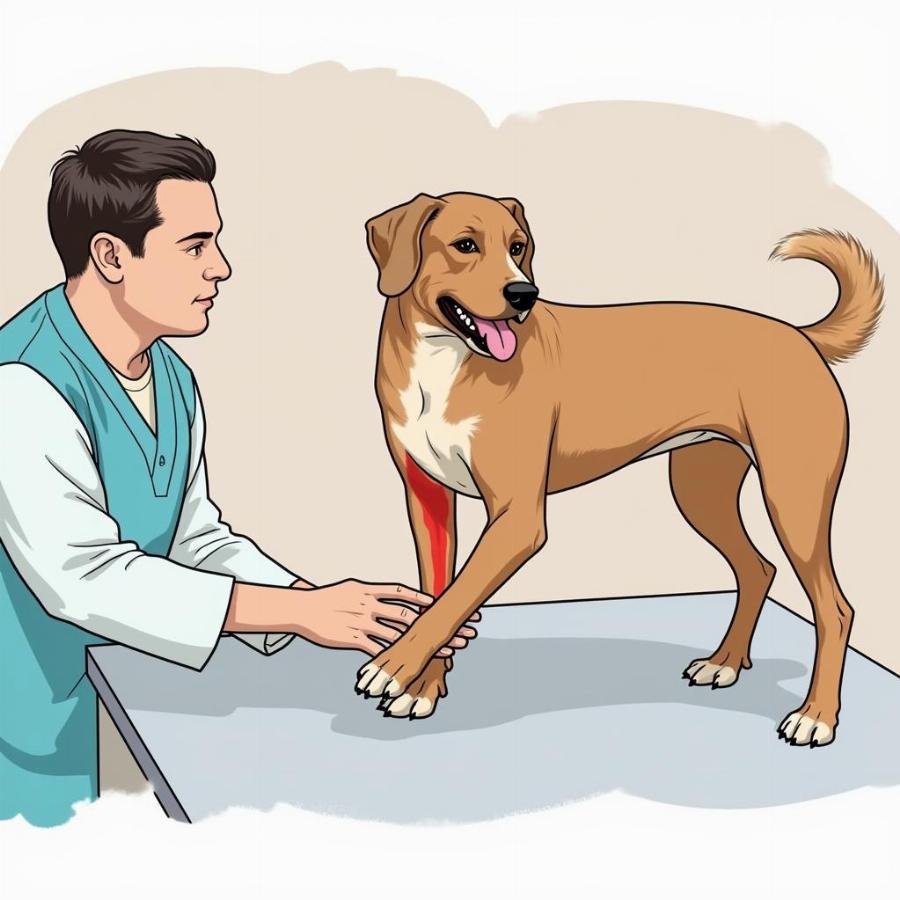Cranial cruciate ligament (CCL) dog surgery is a common procedure performed to repair a torn or ruptured CCL in a dog’s knee. This injury is similar to an ACL tear in humans and can cause significant pain and immobility. Understanding CCL dog surgery options, recovery process, and potential complications is crucial for any dog owner facing this challenging situation.
What is CCL Dog Surgery?
CCL surgery aims to stabilize the knee joint and restore normal function after a CCL injury. There are several surgical techniques available, each with its own advantages and disadvantages. Choosing the right procedure depends on factors like the dog’s size, age, activity level, and the severity of the injury. This surgery is essential for helping your dog regain mobility and live a pain-free life. But how do you know if your dog needs this surgery in the first place?
Diagnosing a CCL Tear in Dogs
Diagnosing a CCL tear involves a thorough physical examination by a veterinarian. The vet will manipulate the knee joint to check for instability and perform specific tests like the “drawer test” or “tibial thrust test”. Sometimes, sedation or anesthesia might be necessary for a complete and accurate diagnosis. Imaging techniques like X-rays can help rule out other conditions and confirm the diagnosis.
 Diagnosing a CCL Tear in a Dog's Knee
Diagnosing a CCL Tear in a Dog's Knee
Different Types of CCL Dog Surgery
Several surgical procedures are available for treating CCL tears in dogs. The most common options include:
- Tibial Plateau Leveling Osteotomy (TPLO): This procedure involves cutting and rotating the top of the tibia (shin bone) to change the angle of the tibial plateau. This reduces the strain on the CCL and stabilizes the knee joint.
- Tibial Tuberosity Advancement (TTA): In TTA surgery, the tibial tuberosity (the bony prominence where the patellar tendon attaches) is advanced forward, changing the forces acting on the knee joint and eliminating the need for a functional CCL.
- Extracapsular Repair: This technique involves placing a suture outside the joint capsule to mimic the function of the CCL. This is generally considered a less invasive option, often suitable for smaller dogs.
- Lateral Suture Stabilization: This method uses sutures placed on the outside of the joint to stabilize it. Similar to extracapsular repair, it’s less invasive and often appropriate for smaller breeds.
How to Choose the Right CCL Surgery for Your Dog?
Choosing the right surgery depends on various factors, and discussing these with your veterinarian is essential. They will consider your dog’s breed, size, age, activity level, and the severity of the CCL tear to recommend the most appropriate procedure. For instance, TPLO is often preferred for larger breeds, while extracapsular repair might be suitable for smaller dogs.
Recovery from CCL Dog Surgery
Regardless of the chosen surgical technique, recovery from CCL surgery requires dedicated care and patience. Post-operative care involves pain management, restricted activity, and a gradual return to normal exercise. Physical therapy plays a vital role in regaining muscle strength and range of motion.
Post-Operative Care for CCL Surgery
Following surgery, your dog will require pain medication and strict rest. Activity should be limited to short leash walks for bathroom breaks. Your vet will provide a detailed rehabilitation plan, which may include exercises, hydrotherapy, or other therapies. Close monitoring of the incision site is crucial to prevent infection.
What are the Potential Complications of CCL Dog Surgery?
While generally safe and effective, CCL surgery carries potential risks like infection, implant failure, or complications with anesthesia. Discussing these risks with your veterinarian is important to make an informed decision. Following the post-operative instructions diligently can significantly reduce the risk of complications.
FAQ about CCL Dog Surgery
- How much does CCL surgery cost? The cost varies depending on the chosen procedure, the veterinarian, and your location.
- How long is the recovery period? Recovery typically takes several months, with a gradual return to normal activity.
- Can CCL tears be prevented? While not always preventable, maintaining a healthy weight and providing regular exercise can help reduce the risk.
Next Steps for Dog Owners Considering CCL Surgery
Understanding the details of CCL dog surgery is crucial for making informed decisions. For more information on related topics, explore our articles on dog acl braces and dog recovery tplo surgery. Understanding the anatomy of dog knee can also be helpful.
Conclusion
CCL dog surgery is a significant procedure that requires careful consideration and planning. Understanding the different surgical options, recovery process, and potential complications is vital for any dog owner facing this situation. By working closely with your veterinarian and following their recommendations, you can help your dog regain mobility and enjoy a happy, pain-free life.
Beaut Dogs is your trusted source for comprehensive information on all aspects of dog care, offering expert advice on everything from breed selection to health and nutrition. For personalized guidance on CCL surgery and other dog care concerns, contact us at Email: [email protected]. We are here to help you provide the best possible care for your beloved canine companion. Visit us at https://beautdogs.com to learn more.